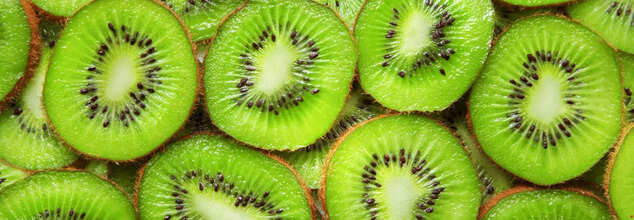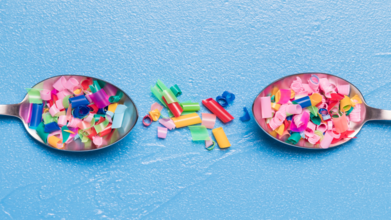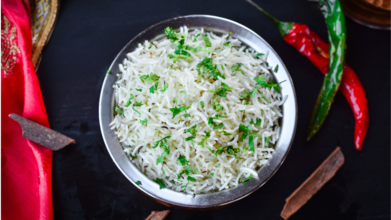- Health Conditions A-Z
- Health & Wellness
- Nutrition
- Fitness
- Health News
- Ayurveda
- Videos
- Medicine A-Z
- Parenting
- Web Stories
Kiwi Skin Has More Antioxidants Than Fruit Itself-But Should You Eat It?

Credit: Canva
A kiwifruit (or kiwi), also known as the Chinese gooseberry, is a nutritious, sweet-tart fruit. About the size of a chicken egg, with a brown fuzzy skin, vibrant green flesh and small black seeds, this fruit is popular for boosting immunity. While many people already love eating kiwi skin, there is still a continued debate over whether they are edible or not. Technically, the skin is edible, but some people dislike its fuzzy texture.
But did you know, the kiwi skin is really nutritious. Kiwi skins contain a high concentration of nutrients, especially fiber, folate and vitamin E.
Kiwi Skin Is Full Of Fibre And Folate
One of the standout nutrients in kiwi skin is fibre. Consuming the skin can increase the fruit’s fiber content by 50%, helping to support gut health by feeding beneficial bacteria. A diet rich in fibre has been linked to a lower risk of heart disease, cancer, and diabetes. Additionally, kiwi skin is a potent source of folate, a nutrient vital for cell growth and division. Folate also plays a crucial role in preventing neural tube defects during pregnancy.
Vitamin E
Vitamin E, a fat-soluble antioxidant, is another nutrient that is significantly more concentrated in kiwi skin than in the flesh. It helps protect cells from damage caused by free radicals, contributing to overall cellular health. Eating the skin can increase vitamin E intake by 34% compared to consuming the flesh alone. Since many people do not get enough of these nutrients in their diet, eating kiwi with the skin can be a practical way to boost intake.
Kiwi Skin Has More Antioxidants Than Fruit Itself
In terms of antioxidant content, the skin holds a particularly high concentration of both water-soluble and fat-soluble antioxidants, such as vitamin C and vitamin E. Vitamin C combats oxidative damage in cells and blood vessels, while vitamin E primarily protects cell membranes from free radicals. Together, these antioxidants provide comprehensive protection against cellular damage throughout the body.
However, the fuzzy texture of kiwi skin can be off-putting for some. Rubbing the fruit with a clean towel, scrubbing it with a vegetable brush, or lightly scraping with a spoon can reduce the fuzz. For those sensitive to texture, peeling the fruit is a viable option, though it reduces nutrient intake.
Despite its nutritional advantages, kiwi skin may not be suitable for everyone. The skin contains calcium oxalate crystals, which can cause mouth irritation, especially in unripe fruits. These tiny crystals can scratch the delicate tissues inside the mouth, leading to a tingling or stinging sensation. Those with a history of kidney stones should also exercise caution, as oxalates can contribute to stone formation.
Moreover, individuals with kiwi allergies or oral allergy syndrome should avoid consuming the fruit, especially the skin. Allergic reactions can range from mild itching and swelling to severe anaphylaxis. Cooking or canning the fruit may reduce the risk of allergic reactions, as heating alters the structure of the allergenic proteins.
Whether or not you eat the skin, kiwis remain a nutrient-dense fruit with several health benefits. Studies suggest that regular kiwi consumption may improve cholesterol levels, lower blood pressure, enhance iron absorption, and aid digestion. With its unique nutrient profile, the kiwi is more than just a refreshing snack—it’s a powerhouse of essential vitamins and minerals.
This Bedtime Drink Could Help You Lose Weight While Balancing Blood Sugar

Credits: Canva
Weight management and blood sugar control are two of the biggest health concerns today, often linked to lifestyle-related conditions such as diabetes, obesity, and metabolic syndrome. While diet and exercise remain the foundation for addressing them, research increasingly points to certain simple, everyday habits that may provide additional support. One such habit involves a bedtime drink that could play a small but meaningful role in promoting weight loss and stabilising blood sugar overnight.
First things first, Apple Cider Vinegar (ACV) is not your average vinegar. Good-quality apple cider vinegar comes with something called “the mother”. This “mother” is the cloudy stuff floating around at the bottom of the bottle, made up of good bacteria, proteins, and enzymes. It is where a lot of the health magic lives.
The acetic acid in vinegar slows down how fast your stomach empties and how quickly sugar gets into your bloodstream. This results in fewer blood sugar spikes, fewer cravings, and possibly, fewer late-night binge eating sessions.
How Vinegar Helps In Weight Loss
ACV is not a miracle weight-loss potion that will have you waking up with abs. But studies do hint at some benefits. Drinking diluted ACV can make you feel fuller, so you do not attack breakfast. At night, it may even work quietly to improve how your body handles sugar while you snooze.
Stable blood sugar means fewer mood swings and fewer 4 pm “must eat chocolate now or will scream” moments. Some small studies even suggest acetic acid might nudge your metabolism into burning a smidge more fat and storing a little less.
The Blood Sugar Bedtime Trick
For anyone watching their blood sugar, a glass of water with a spoon or two of ACV before bed has been linked to lower fasting blood sugar the next morning. Because vinegar helps your body become more sensitive to insulin, which means your body handles the sugar it already has more efficiently.
To be clear, this does not replace medication or advice from your doctor. But as a nightly ritual, it could give your system an extra hand.
How Not to Burn Your Throat
Do not, under any circumstance, chug ACV straight from the bottle. ACV is super acidic and can wreck your teeth or irritate your throat.
Here is how to do it properly:
- Mix 1–2 teaspoons in a big glass of water (never more than that)
- Drink it about 20–30 minutes before bed
- Use a straw to save your teeth from acid erosion
- Rinse your mouth afterwards
- If it still tastes like sadness, stir in a dash of honey or cinnamon
Not Everyone’s Cup of Vinegar
If you’ve got stomach ulcers, reflux, kidney issues, or you are on meds for diabetes or heart health, double-check with your doctor before hopping on the ACV bedtime train. It can mess with certain medications or make existing issues worse.
Does sipping apple cider vinegar before bed melt away fat overnight?
No. But it can be an easy, low-effort habit that gives your body a little boost: steadier blood sugar, fewer cravings, and maybe a small push toward weight loss.
Microplastics Are Invading Your Brain: Here's How To Filter Them Out Of Your Drinking Water

Credits: Freepik
Small pieces of plastic, microplastics and their minute variations, nanoplastics—are appearing in some of the most unlikely locations: from the tops of mountains to the bottoms of the ocean's deepest trenches, and now, within the human body. Researchers have found these particles in lungs, placentas, blood vessels, and recently, in brain tissue, over the last decade. The results are disquieting, but the science still needs to catch up to describe precisely how these plastics are affecting us.
Increasing evidence is pointing to potential connections between exposure to microplastics and cardiovascular, neurological, and metabolic health hazards. Meanwhile, other research is investigating simple solutions, such as boiling tap water, to reduce the amount of plastic we consume. Together, these two lines of scientific inquiry—identifying risks and field-testing simple solutions—are fueling a public health dialogue that can no longer be dismissed.
Why Are Microplastics Everywhere?
Microplastics are plastic pieces less than 5 millimeters in size, and nanoplastics measure in billionths of a meter. Microplastics can come from littered packaging, plastic clothing fibers, broken-down plastic bottles, or industrial pollutants. Once released into the environment, they become transported by wind, flow into groundwater, or accumulate in the food chain through fish, meat, and vegetables.
The most headline-grabbing discovery came earlier this year when researchers reported finding microplastics in donated human brain tissue. The study, published in Nature Medicine, compared brain samples collected in 2016 with those from 2023. The later samples contained far higher concentrations, suggesting accumulation is accelerating over time. The top researcher, US toxicologist Matthew Campen, estimated that up to 10 grams of plastic—about the size of a small crayon—could be separated from one human brain.
If that's correct, the implications are staggering: microplastics could be penetrating the blood-brain barrier, the body's natural protective mechanism meant to prevent unwanted substances from entering.
Why Are Experts Advising Caution?
Not everyone is convinced by these initial results. Toxicologists like Theodore Henry at Heriot-Watt University have called for caution, citing the fact that the evidence base is still thin and confirmation is required. Others, like chemist Oliver Jones of RMIT University, say it's not likely brains will have more microplastics than raw sewage, as some estimates suggested. Significantly, the people involved in these investigations were otherwise healthy at the time of death, and no direct proof was found to connect microplastics with disease.
Nevertheless, more scientists are cautioning against holding off until they are absolutely sure. Observational studies, though not conclusive, are sounding the alarm. For example, a study in the New England Journal of Medicine associated microplastic deposits in arteries with increased risks of heart attack, stroke, and death among patients with artery disease. In animal models, microplastics have caused blood clots, disrupted cell function, and even changed gut microbiomes.
The World Health Organization has concluded that evidence is still "insufficient to determine risks to human health." But as the Barcelona Institute for Global Health emphasized in a 2024 report, "policy decisions cannot wait for complete data."
The sense of urgency comes from the sheer volume of plastic manufacturing. Since 2000, production has doubled and is projected to triple yet again by 2060. Each phase of the plastic lifecycle—production through disposal—emits microscopic particles that find their way into air, soil, and water. That means people are exposed all the time, usually unknowingly.
It could be particularly at risk for children, pregnant women, and individuals with underlying medical conditions. Even if microplastics are not as dangerous as everyone has feared, the sheer number of people exposed across the world means it's an important public health concern.
Simple Ways To Remove Microplastics From Water
Although the long-term health impacts are disputed, scientists are starting to find simple measures to cut down on daily exposure. A 2024 research report from Guangzhou Medical University and Jinan University in China discovered that boiling tap water prior to consumption could filter out as much as 90 percent of nanoplastics and microplastics, depending on how many minerals the water contained.
This is how it goes, hard tap water (high in calcium carbonate) is boiled, and limescale is created, catching plastic pieces within. The encrusted pieces can then be strained out with as much as a stainless-steel strainer or a tea mesh. Even soft water resulted in a decrease of approximately 25 percent of plastic after boiling.
The findings, reported in Environmental Science & Technology Letters, indicate that a common home practice of boiling water might be one of the most readily available protections against microplastic contamination. It's not an end-all solution but is something anyone can do without needing fancy equipment.
Drinking water is just half the story. Microplastics have been found in bottled water, seafood, table salt, honey, and even fresh vegetables. Cooking in non-stick pans, reheating food in plastic containers, and eating packaged foods can all contribute to the body's plastic load.
Boiling water, therefore, must be seen as a complementary approach, not a panacea. Experts suggest that it be used in combination with larger strategies, including less plastic packaging, spending on high-tech municipal filtration plants, and urging industry to change to biodegradable materials.
Microplastics have come to dominate global disputes about plastic pollution. As UN member nations finalize the world's first treaty to limit plastic waste, health science has taken on a growing prominence. Policymakers are being called upon to balance precautionary action, even without conclusive evidence of harm.
Activists contend that waiting for decades worth of data would be risky considering how fast plastics are piling up in the environment and in human bodies. Instead, they advocate a two-pronged strategy of drastic curtailment of plastic manufacture and real-world steps to restrict personal exposure.
THIS Is The Only Right Way To Store Leftover Rice If You Do Not Want To Fall Seriously Sick

Credits: Canva
For many, cooking rice is the easiest job and for the right reasons, you can cook a lot and store it for later. But the problem is not that; it is about how you store it. Lurking in your pile of grains is a hidden bacterium called Bacillus cereus. It thrives on raw rice and survives even after cooking. And the alarming bit is that if you do not store your rice correctly, this bacterium can multiply, releasing toxins that can cause food poisoning.
Food poisoning could lead to vomiting, diarrhoea, cramps, and, in rare cases, infections so severe they can cause organ failure. It is scary, but the worst part is that you cannot see, smell, or taste the danger. A bowl of rice can look perfectly fine while it can quietly wreak havoc in your stomach.
A common thing we all do is leave the leftover rice in the kitchen or on the dining table with just a lid on. But it is more than that, and it is the temperature that plays an important role. So, we are making a huge mistake if we leave it at room temperature.
Here is the safer way to deal with leftover rice and cut the risk of falling seriously sick:
Unlike pasta or potatoes, rice is classed as a high-risk food once cooked. In commercial kitchens, chefs treat it with caution. It is rarely kept overnight and almost never used the next day. That is because of Bacillus cereus and its stubborn little spores.
The Spores That Survive the Heat
Cooking rice does not wipe out Bacillus cereus. The spores are heat-resistant, which means they are still alive and kicking after you have drained your pan. Once the rice cools down, those spores can multiply into bacteria at lightning speed. The longer your rice sits at room temperature, the more the bacteria multiply. And unfortunately, their toxic by-products do not just disappear when you put the rice in the microwave.
Reheating rice does not make it safe. The toxins Bacillus cereus produces are heat-stable. They survive your microwave, oven, or stove reheat session. That means the rice could look fine, taste fine, and even smell fine, but still make you sick.
The Common Storage Mistake
Where do most people go wrong? They leave the rice out too long before refrigerating it. That is more than enough time for Bacillus cereus to thrive and pump toxins into your rice. The second mistake is thinking that reheating alone will make it safe. Unfortunately, it will not. As TikTok chef Joshy Jin says, those toxins are invisible, tasteless, and can survive heating. A bowl that looks perfectly fine can knock you down with food poisoning in just hours.
How to Store Leftover Rice the Right Way
If you must keep leftover rice, speed is everything. Here is what food safety experts and chefs recommend:
- Cool it fast. Spread the rice out on a plate or baking tray so it cools within 10 minutes. Clumping it in a pot traps heat and gives bacteria time to multiply.
- Refrigerate quickly. Once it is no longer steaming, cover it and get it into the fridge. Do not leave it hanging out on the counter.
- Stick to the 24-hour rule. The Food Standards Agency advises eating refrigerated rice within one day. Some chefs say two, but the fresher, the safer.
- Reheat until piping hot. If you do reheat, make sure it is steaming all the way through, not just lukewarm in the middle.
Fresh is Best Any Day
Rice is deceptively dangerous when it comes to leftovers. Bacillus cereus spores are survivors, and once they release toxins, no amount of reheating can save your meal. The safest thing to do is to cook only what you need. If you are planning fried rice tomorrow, store it properly, cool it fast, and keep it in the fridge for no longer than a day. But otherwise, embrace the ritual of fresh rice-making.
© 2024 Bennett, Coleman & Company Limited

